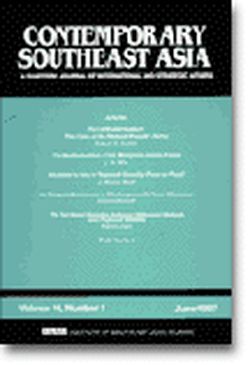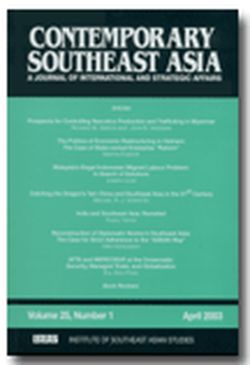Contemporary Southeast Asia: A Journal of International and Strategic Affairs. Vol. 27/3 (Dec 2005)

Date of publication:
December 2005
Number of pages:
203
Code:
CS27/3
Contents
-
Contemporary Southeast Asia: A Journal of International and Strategic Affairs. Vol. 27/3 (Dec 2005)
-
Preliminary pages
- ARTICLES
-
Delegitimizing Global Jihadi Ideology in Southeast Asia, by Kumar Ramakrishna, author see abstractThis article argues that countering radical Islamist ideology is central to any counter-terrorism strategy in Southeast Asia. It shows that while enhanced inter-state cooperation may contribute to the elimination of existing terror cells and individual terrorist leaders and rank and file, this will by no means be sufficient to neutralize the terror threat. This is because the relatively uncontested circulation of a dangerous apocalyptic global jihadi narrative only ensures that the threat persists. The article lays bare the content and danger of the global jihadi Story of a transnational Islamic community under attack by a nefarious Jewish-Crusader axis spearheaded by Israel and the United States. It essentially examines how, within the Southeast Asian milieu, the Story is empowered by several macropolitical oxygen and micropolitical oxygen, including localized political, cultural, and socioeconomic grievances as well as resentment at the perceived bias of the United States against the Muslim world. In particular, the study explores how all these elements may have interacted to reinforce the Story empowering the regional radical Islamist terrorist network Jemaah Islamiyah. The essay concludes by suggesting possible counter-strategies for de-legitimizing the Story driving global jihadi terrorism in Southeast Asia.
-
Non-official Diplomacy in Southeast Asia: "Civil Society" or Civil Service?, by Tan See Seng, author see abstractNon-official diplomacy in Southeast Asia has been viewed by some as emblematic of a growing and thriving civil society throughout the region, but by others as a sort of shadow civil service in support of regional governments and their policies. A closer reading of non-official diplomacy proffers a more complex picture that calls into question the supposed coherence of that distinction. This article traces the evolution of this diplomatic form in Southeast Asia in the post-Cold War era, paying close attention to its processes. More specifically, it seeks to unpack the practices in which regional non-official diplomatic agents engage that make them not only civil society participants who potentially if only inadvertently challenge extant conventions of interstate diplomacy based on raison d'etat, but by the same token civil servants (or statesmen) who promote and protect state interests, and, in so doing, paradoxically reconstitute those very conventions.
-
Transforming the Strategic Landscape of Southeast Asia, by Bernard Fook Weng Loo, author see abstractThis article examines the implications for the regional strategic landscape of uneven regional military modernization in Southeast Asia. At heart, there is a fundamental issue that pertains to all military modernization no military force can afford to be static in nature and capability. To remain relevant and effective, all military forces have to undergo periodic change, both in terms of their hardware and capabilities on the one hand, but also in terms of their doctrines and strategies, as capabilities change. As strategic conditions in Southeast Asia change the demise of traditional internal security concerns revolving around revolutionary or armed separatist movements, and the movement towards greater emphasis on external security concerns this has facilitated the increasing attention that regional armed forces have paid to the process of transformation from counter-insurgency towards conventional military postures and force structures. However, the ever-increasing pace of modern technological change and the increasingly high costs of modern military technologies complicate this modernization process. Not all states in Southeast Asia can actually financially afford to support this military modernization. This has resulted in an uneven process of regional military modernization that can shape the security environment of the region in ways that cannot be anticipated.
-
Democracy in Cambodia One Decade, US$5 Billion Later: What Went Wrong?, by Ronald Bruce St John, author see abstractIn an age of heightened emphasis on democratization, the Royal Government of Cambodia illustrates many of the serious challenges which must be addressed to implant and nurture democracy in less developed political economies. The national elections conducted in 1993, celebrated at the time as a unique achievement, failed to spark requisite change in the political culture of Cambodia. Rejecting central elements of the democratic process, such as power-sharing and loyal opposition, the Cambodian elite later drew on long familiar aspects of traditional political culture to promote modernization within an authoritarian political model. The international community, which provided some US$5 billion in aid to the Royal Government of Cambodia over the ensuing decade, was complicit in the creation of this new political order in that it long hesitated to make the provision of aid conditional on meaningful political reform. With the end of the Cold War, the number of states embracing some form of democratic government dramatically increased. Early in his first term, President Bill Clinton proclaimed democracy was on the march around the globe. President George W. Bush later articulated a bold strategy to spread freedom and democracy throughout the world. Given the widespread interest in democratization and the spread of civil society, the Cambodian experience after 1993 provides a sobering example of the challenges which must be addressed to nurture democracy in less developed political economies.
-
The Management of Vietnams Border Disputes: What Impact on Its Sovereignty and Regional Integration?, by Ramses Amer, Nguyen Hong Thao, authors see abstractThe main aim of this article is to study Vietnam's border disputes, the way they have been and are being managed and the challenges that the remaining disputes pose.1 It also assesses the impact of Vietnam's border disputes on Vietnam's sovereignty, as well as the impact of the border disputes on Vietnam's regional integration. The study focuses on developments since the early 1990s. The progress in managing and resolving Vietnam's border disputes is outlined. The remaining unresolved disputes are analyzed and the challenge they pose is discussed. The degree of success in managing Vietnam's border disputes is examined through the pattern of negotiations involving Vietnam and its neighbours. The impact of the border disputes on Vietnam's sovereignty is studied from two main perspectives: the first relates to how unresolved border disputes affect Vietnam's sovereignty, in particular, Vietnam's capability in efficiently exercising its sovereignty; the second deals with the impact of the agreements reached on border disputes on Vietnam's sovereignty. The regional integration dimension is studied primarily from the perspective of how Vietnam contributes to the enhancement of the conflict management approach of the Association of Southeast Asian Nations (ASEAN).
-
Politics in Command: The Case of the US Proposal for an FTA with the Philippines, by Renato Cruz De Castro, author see abstractThis research examines the politico-strategic motivations of the Bush Administration in fostering Free Trade Agreements (FTAs) with a number of countries, including the Philippines. The article observes that the current efforts of the Bush Administration to push for FTAs are driven by political dynamics, which include, among others, its trade agenda, the US strategy in the war on terror, and the need to ensure American access to the rapidly changing East Asian regional economy. It then discusses the specific politico-strategic motives of the Bush Administration in its offer of an FTA to the Philippines. In conclusion, the article explores the prospects of a successful FTA between the two allies.
-
Challenges of Globalization: Malaysia and India Engagement, by Faizal Yahya, author see abstractThis article examines the emerging relations between India and Malaysia in the context of challenges posed by globalization and how these could be overcome by enhancing bilateral and regional linkages. It argues that globalization in the post-Cold War era has resulted in more visible trends towards economic integration. Due to the inability of the South Asian Association for Regional Cooperation (SAARC) to increase intra-regional trade, India is looking towards other regional organizations such as ASEAN to strengthen its trading links. Furthermore, there are other factors pushing India to enhance ties with ASEAN, such as the emergence of China as a competitor. Malaysia is India's largest trading partner from the ASEAN region. During the process of India's transition from a sectoral to a full dialogue partner in ASEAN, Malaysia also played a pivotal role as India's country coordinator and was tasked to integrate India further into the ASEAN region. India and Malaysia were also chosen because of their historical, cultural, social, and religious linkages. However, there remain impediments to the strengthening of bilateral ties, such as Malaysia's stand on Kashmir an issue importing a Muslim dimension that evidently impacts upon India-Pakistan relations, and Kuala Lumpur's close ties with the Muslim world through membership in the Organization of Islamic Conference (OIC).
-
Cultural Commodities and Regionalization in East Asia, by Nissim Kadosh Otmazgin, author see abstractIn order to characterize and explain regional formation processes, theories in the field of international relations have focused primarily on political and economic parameters that were drawn from experiences in Western Europe. In East Asia, however, it is often mentioned that regional dynamism and cross-border economic activities, rather than formal agreements between governments, or shared historical or cultural Asian background generates the formation of the region. This article, however, examines the role popular culture plays in shaping and regionalizing East Asia. It focuses on the process by which confluences of culture have diffused throughout East Asian markets in the decades surrounding the 1990s and the concurrent formation of regional media alliances. An attempt is made to go beyond state-centric explanations of regionalization and extend the cultural approach to regionalization, demonstrating how popular culture can affect regional formation.
- BOOK REVIEWS
-
BOOK REVIEW: My Side of History. By Chin Peng, by Anthony S K Shome, author
-
BOOK REVIEW: Regionalism in Post-Suharto Indonesia. Edited by Maribeth Erb, Priyambudi Sulistiyanto, and Carole Faucher, by Howard M Federspiel, author
-
BOOK REVIEW: State and Society in the Philippines. By Patricio N Abinales and Donna J Amoroso, by Noel M Morada, author
-
BOOK REVIEW: International Relations in Southeast Asia: The Struggle for Autonomy. By Donald E Weatherbee et al., by Mark Beeson, author
-
BOOK REVIEW: India Briefing: Takeoff at Last? Edited by Alyssa Ayres and Philip Oldenburg, by W Lawrence S Prabhakar, author
-
BOOK REVIEW: The Emergence of Modern Southeast Asia: A New History. Edited by Norman G Owen, by Tin Maung Maung Than, author





